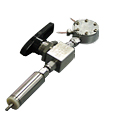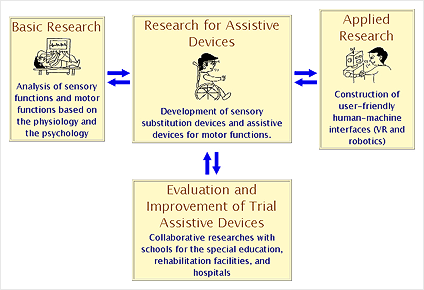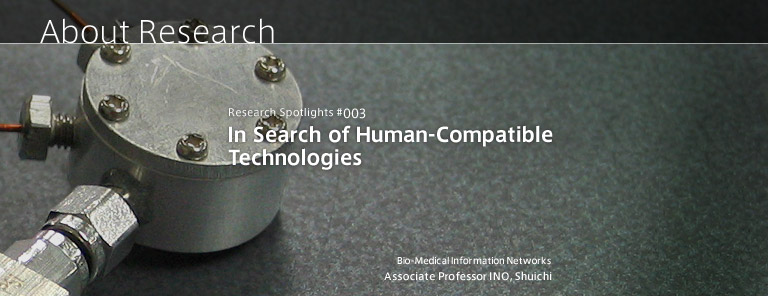It looks more like a workshop than a laboratory. Shelves are stocked with electronic parts, and a lathe and facilities for welding are set up in the basement. There is even a soundproof chamber.
Associate Professor Shuichi Ino's specialty is "rehabilitation engineering." He develops technologies to support weakened functions in the human body. With Professor Tohru Ifukube of the same laboratory, he has developed an artificial larynx capable of inflection, for example, which vibrates the throat to generate a voice, as well as a captioning system using the automatic speech recognition. All these devices are designed to be used by real-life human beings.

-
When Ino was an undergraduate, through trial and error he created a laser oscillation device employing a transparent glass tube, and used it to measure levels of carbon dioxide. Though he understood the importance of measuring atmospheric concentrations, he had always been most interested in working with people, which led him to study carbon dioxide levels in human exhaled breath. Then in graduate school, he continued his studies in Professor Ifukube's laboratory.
The Challenge of "Softness"
One of the research projects he is currently working on involves the use of a unique powdered "metal hydride alloy" to create devices that can be easily attached to the human body. When the alloy is heated to a temperature greater than 20 degrees Celsius, it releases a large amount of hydrogen, and when it is cooled it absorbs hydrogen. Because of its capability for the thousand-fold change in the volume, the alloy is used to power machines.
Installed on a wheelchair, for example, it can be used to raise the seat in order to support the movement of standing up; while another device can work to gently move and loosen areas of the body that have been rendered immobile due to a cast set for a broken bone or as the result of a stroke, and thus prevent contracture of the joints.

-
Because these devices come into direct contact with the human body, they have to be comfortable. Light, small, powerful, soft, and inaudible. Fifteen years ago, when he was searching for such materials, he happened upon the metal hydride alloy. To allow heat to be easily transmitted throughout the entire volume of the metal, he ground it into powder and coated with a copper film. He also has invented a new soft container for hydrogen, like a retort pouch, instead of a hard metal one. He is currently working to improve a device that can be comfortably fitted to a joint such as the elbow.
Back to Fundamental Physics
Several other research projects are simultaneously underway in the Ifukube-Ino laboratory.
"It would be nice if we had something like this," they first think, and with a particular idea in mind, they visit corporate or university laboratories to ask or talk about potentially useful materials or devices. From there, they collaborate to create what they need. At times this work brings them back to fundamental principles. They sometimes conduct even psychological tests from the point of view of the users of their devices. "I myself am a graduate in electrics engineering," he said, "and there are people in the lab who have been trained in many different areas, such as mechanical engineering, information science, biotechnology, and physics. In the lab next door there are specialists in psychology and pedagogy, both related to issues of universal accessibility for the handicapped. All our different specialties are naturally put to use in each others' research." For that reason, he said, the foundation of knowledge formed during one's undergraduate studies turns out to be important.
The laboratory also has accepted graduate students who are certified physical therapists, for example, or those from governmental industrial research institutes, to collaborate on studies. Always imagining how its creations will actually be used, this team continues to advance its research on human-compatible technologies.

Interviewer: Tomohisa SUMIDA
(November 9, 2005)


